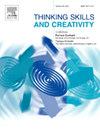高阶思维技能层次演化的中介机制:中国科学教育的纵向研究
IF 4.5
2区 教育学
Q1 Social Sciences
引用次数: 0
摘要
本研究探讨了132名中国七年级学生高阶思维技能(HOTSs)内部演化的中介机制,重点研究了特定HOTSs (S-HOTSs:循证推理、模型构建、系统思维和批判性讨论技能)与复杂HOTSs (C-HOTSs:批判性思维和解决问题技能)之间的层次关系。本研究采用纵向设计,结合形成性评估和总结性评估,采用单链和链式中介模型分析了hots在9节生物科学课程中光合作用、呼吸作用和食物链的发展。结果表明,S-HOTS通过顺序介导途径间接促进C-HOTS,且链式介质的作用强于直接作用。值得注意的是,模型构建和系统思维技能是早期HOTSs发展和后期HOTSs发展的关键中介。这些发现强调了与分层技能进化相一致的逐步教学策略的重要性,为设计促进科学教育中hots发展的课程提供了实证见解。本文章由计算机程序翻译,如有差异,请以英文原文为准。
Mediation mechanisms in the hierarchical evolution of high-order thinking skills: A longitudinal study in Chinese science education
This study investigated the mediation mechanisms underlying the internal evolution of high-order thinking skills (HOTSs) among 132 seventh-grade students in China, focusing on the hierarchical relationships between specific HOTSs (S-HOTSs: evidence-based reasoning, model construction, systematic thinking and critical discussion skills) and complex HOTSs (C-HOTSs: critical-thinking and problem-solving skills). Using a longitudinal design with formative and summative assessments, the study employed single and chain mediation models to analyze HOTSs development during a 9-session biological science course on photosynthesis, respiration and the food chain. The results revealed that S-HOTS indirectly promote C–HOTS through sequential mediation pathways, with stronger effects from chain mediators compared to direct effects. Notably, model construction and systematic thinking skills emerged as pivotal mediators, bridging early-developing HOTSs and later-developing HOTSs. These findings highlighted the importance of stepwise instructional strategies aligned with hierarchical skill evolution, offering empirical insights for designing curricula that foster the development of HOTSs in science education.
求助全文
通过发布文献求助,成功后即可免费获取论文全文。
去求助
来源期刊

Thinking Skills and Creativity
EDUCATION & EDUCATIONAL RESEARCH-
CiteScore
6.40
自引率
16.20%
发文量
172
审稿时长
76 days
期刊介绍:
Thinking Skills and Creativity is a new journal providing a peer-reviewed forum for communication and debate for the community of researchers interested in teaching for thinking and creativity. Papers may represent a variety of theoretical perspectives and methodological approaches and may relate to any age level in a diversity of settings: formal and informal, education and work-based.
 求助内容:
求助内容: 应助结果提醒方式:
应助结果提醒方式:


